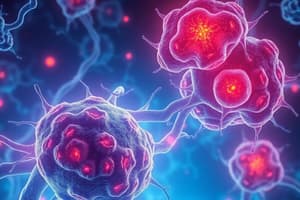Podcast
Questions and Answers
What is the primary role of oncogenes in cancer development?
What is the primary role of oncogenes in cancer development?
- To trigger apoptosis
- To promote DNA repair mechanisms
- To induce cell differentiation
- To increase the rate of cell growth (correct)
Which of the following accurately describes one of the hallmarks of cancer?
Which of the following accurately describes one of the hallmarks of cancer?
- Evading growth suppressors (correct)
- Increasing the reliance on aerobic respiration
- Promoting immune response against tumors
- Sustaining apoptosis during cell stress
What process does the central dogma of biology describe?
What process does the central dogma of biology describe?
- DNA replication to RNA to protein (correct)
- RNA synthesis from proteins
- DNA alteration to bypass normal functions
- Protein synthesis from proteins
Which alteration is considered a genetic change that can lead to cancer?
Which alteration is considered a genetic change that can lead to cancer?
How do cancer cells typically evade programmed cell death?
How do cancer cells typically evade programmed cell death?
Which cellular component plays a crucial role in signaling cell division when growth factors bind?
Which cellular component plays a crucial role in signaling cell division when growth factors bind?
What is the significance of tumor heterogeneity in cancer treatment?
What is the significance of tumor heterogeneity in cancer treatment?
What is a common effect of epigenetic alterations in cancer cells?
What is a common effect of epigenetic alterations in cancer cells?
What is the primary characteristic that differentiates cancer cells from normal cells?
What is the primary characteristic that differentiates cancer cells from normal cells?
Which of the following is a preventable lifestyle factor linked to cancer risk?
Which of the following is a preventable lifestyle factor linked to cancer risk?
Which cancer classification occurs in soft tissues such as muscles and cartilage?
Which cancer classification occurs in soft tissues such as muscles and cartilage?
What is the significance of tumour heterogeneity in cancer treatment?
What is the significance of tumour heterogeneity in cancer treatment?
Which type of cancer is associated with abnormalities in blood cells?
Which type of cancer is associated with abnormalities in blood cells?
Which of the following is a factor that is not considered a preventable risk for cancer?
Which of the following is a factor that is not considered a preventable risk for cancer?
Which term refers to cancers arising from epithelial tissues?
Which term refers to cancers arising from epithelial tissues?
Which type of cancer is specifically linked to infections caused by HPV?
Which type of cancer is specifically linked to infections caused by HPV?
Flashcards are hidden until you start studying
Study Notes
Definition and Classifications of Cancer
- Cancer involves uncontrollable cell growth that invades surrounding tissues and can metastasize to other body parts.
- Tumours are categorized as benign (e.g., moles) or malignant (cancerous), which possess the ability to spread.
- Approximately 10% of cancers are inherited; however, the majority are not.
- Cancer has a potential for recurrence, regardless of initial treatment.
- Classifications of cancer: Carcinoma, Sarcoma, Myeloma, Leukaemia, Lymphoma, and Mixed types.
Types of Cancer
- Carcinoma: Most common; originates from epithelial cells. Examples include colon adenocarcinoma and squamous cell carcinoma.
- Sarcoma: Develops in bone, tendons, and connective tissues, such as muscle and cartilage; includes glioma (neurogenic connective tissue).
- Myeloma: Cancer arises in bone marrow plasma cells.
- Leukaemia: Cancer affecting blood cells; examples include myeloid leukaemia.
- Lymphoma: Cancer of lymphatic glands or nodes.
- Mixed types: Includes adenosquamous carcinoma and teratocarcinoma.
Cancer Risk Factors
- Biomedical Factors: Non-preventable risks including genetic susceptibility, hormonal factors (especially in females), and other endogenous factors like age and ethnicity (e.g., nasopharyngeal carcinoma is more common in Asians).
- Lifestyle Factors: Preventable risks involving smoking, alcohol consumption, physical inactivity, chronic infections (e.g., cervical cancer), and dietary choices (e.g., high red meat intake linked to prostate cancer).
- Environmental Factors: Preventable including exposure to sunlight, radiation, occupational hazards, and pollution.
Differences Between Normal and Cancer Cells
- Normal Cells: Follow a cycle of growth, division, and programmed cell death.
- Cancer Cells: Exhibit continuous growth and division, becoming immortal, and disrupt normal organ function.
- Cancer development often results from genetic and epigenetic changes, involving multiple mutations and alterations at the RNA level.
Importance of Tumour Heterogeneity
- Tumours display significant diversity, with varying resistance to treatment among cells.
- Treatment challenges arise from numerous potential genetic alterations and interactions with surrounding cells and immune response.
Molecular and Cellular Basis of Cancer
- Cancer emerges from molecular and cellular level abnormalities.
- Errors in the cell cycle stem from abnormal molecular changes linked to hallmarks of cancer.
Central Dogma of Biology
- DNA transcribes to mRNA, which translates to proteins; mutations in the mRNA "recipe" can result in cancerous cells.
- DNA serves as a "cookbook"; mRNA as the "recipe", while the protein is the final "product."
- Types of genetic alterations include point mutations, frameshifts, and epigenetic changes.
Cell Cycle Regulation
- Growth factors bind to cell membrane receptors, activating signal transduction pathways that regulate cell cycle progression.
- Disruption of normal cell cycle regulation can lead to cancer.
Hallmarks of Cancer
- Sustaining Proliferative Signaling: Oncogenes (e.g., HER2, RAS, MYC) promote cell growth.
- Evading Growth Suppressors: Loss of function in tumor suppressor genes (e.g., p53) leads to uncontrolled cell proliferation.
- Resisting Cell Death: Overexpression of anti-apoptotic proteins (e.g., BCL2, BCLX) prevent programmed cell death, allowing survival of damaged cells.
- Enabling Replicative Immortality: Cancer cells bypass limitations on cell division, contributing to tumor growth and persistence.
Studying That Suits You
Use AI to generate personalized quizzes and flashcards to suit your learning preferences.



